Related Research Articles

A brig is a type of sailing vessel defined by its rig: two masts which are both square-rigged. Brigs originated in the second half of the 18th century and were a common type of smaller merchant vessel or warship from then until the latter part of the 19th century. In commercial use, they were gradually replaced by fore-and-aft rigged vessels such as schooners, as owners sought to reduce crew costs by having rigs that could be handled by fewer men. In Royal Navy use, brigs were retained for training use when the battle fleets consisted almost entirely of iron-hulled steamships.
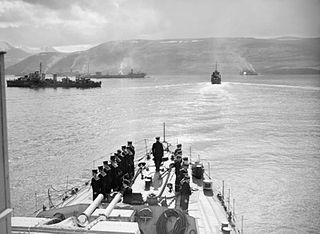
PQ 17 was the code name for an Allied Arctic convoy during the Second World War. On 27 June 1942, the ships sailed from Hvalfjörður, Iceland, for the port of Arkhangelsk in the Soviet Union. The convoy was located by German forces on 1 July, after which it was shadowed continuously and attacked. The First Sea Lord Admiral Dudley Pound, acting on information that German surface units, including the German battleship Tirpitz, were moving to intercept, ordered the covering force built around the Allied battleships HMS Duke of York and the USS Washington away from the convoy and told the convoy to scatter. Because of vacillation by Oberkommando der Wehrmacht, the Tirpitz raid never materialised. The convoy was the first large joint Anglo-American naval operation under British command; in Churchill's view this encouraged a more careful approach to fleet movements.
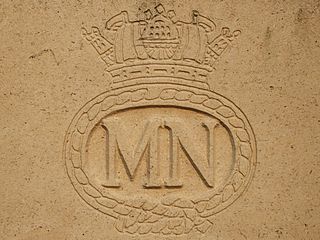
The Merchant Navy is the maritime register of the United Kingdom and comprises the seagoing commercial interests of UK-registered ships and their crews. Merchant Navy vessels fly the Red Ensign and are regulated by the Maritime and Coastguard Agency (MCA). King George V bestowed the title of "Merchant Navy" on the British merchant shipping fleets following their service in the First World War; a number of other nations have since adopted the title. Previously it had been known as the Mercantile Marine or Merchant Service, although the term "Merchant Navy" was already informally used from the 19th century.

Bonhomme Richard, formerly Duc de Duras, was a warship in the American Continental Navy named for Founding Father Benjamin Franklin. She was originally an East Indiaman, a merchant ship built in France for the French East India Company in 1765, for service between France and Asia. She was placed at the disposal of John Paul Jones on 4 February 1779, by King Louis XVI of France as a result of a loan to the United States by French shipping magnate Jacques-Donatien Le Ray.

The Battle of the Barents Sea was a World War II naval engagement on 31 December 1942 between warships of the German Navy (Kriegsmarine) and British ships escorting convoy JW 51B to Kola Inlet in the USSR. The action took place in the Barents Sea north of North Cape, Norway. The German raiders' failure to inflict significant losses on the convoy infuriated Hitler, who ordered that German naval strategy would henceforth concentrate on the U-boat fleet rather than surface ships.
Nathaniel Drinkwater is a fictional character, the protagonist of a series of novels by Richard Woodman. In the series, he is an officer in the British Royal Navy during the Napoleonic Wars.

The Battle of Pulo Aura was a minor naval engagement of the Napoleonic Wars, fought on 14 February 1804, in which a large convoy of Honourable East India Company (HEIC) East Indiamen, well-armed merchant ships, intimidated, drove off and chased away a powerful French naval squadron. Although the French force was much stronger than the British convoy, Commodore Nathaniel Dance's aggressive tactics persuaded Contre-Admiral Charles-Alexandre Durand Linois to retire after only a brief exchange of shot. Dance then chased the French warships until his convoy was out of danger, whereupon he resumed his passage toward British India. Linois later claimed that the unescorted British merchant fleet was defended by eight ships of the line, a claim criticised by contemporary officers and later historians.

Sir Nathaniel Dance was an officer of the East India Company who had a long and varied career on merchant vessels, making numerous voyages to India and back with the fleets of East Indiamen. He was already aware of the risks of the valuable ships he sailed on being preyed on by foreign navies, having been captured by a Franco-Spanish fleet in 1780 during the East Indies campaign of the American War of Independence. His greatest achievement came during the Napoleonic Wars, when having been appointed commodore of one of the company's fleets, he came across a French squadron under Rear-Admiral Comte de Linois, which was raiding British shipping in the area.

The action of 6 November 1794 was a naval engagement during the French Revolutionary Wars. Two British ships of the line, HMS Alexander and HMS Canada were intercepted while returning to Britain through the Celtic Sea by a large French squadron. The French squadron had sailed from Brest in search of an inward bound British convoy in October, but instead encountered the two British ships returning from escorting an outward-bound convoy. There had been no warning of the French approach as the British force assigned to watch Brest was absent at Plymouth due to the policy of operating a distant blockade.

HMAS Gladstone (J324/M324), named for the city of Gladstone, Queensland, was one of 60 Bathurst class corvettes constructed during World War II, and one of 36 that were initially manned and commissioned solely by the Royal Australian Navy (RAN). Built by Walkers Limited, the ship was commissioned in 1943.

Linois's expedition to the Indian Ocean was a commerce raiding operation launched by the French Navy during the Napoleonic Wars. Contre-Admiral Charles-Alexandre Durand Linois was ordered to the Indian Ocean in his flagship Marengo in March 1803 accompanied by a squadron of three frigates, shortly before the end of the Peace of Amiens. When war between Britain and France broke out in September 1803, Marengo was at Pondicherry with the frigates, but escaped a British squadron sent to intercept it and reached Isle de France. The large distances between naval bases in the Indian Ocean and the limited resources available to the British commanders in the region made it difficult to concentrate sufficient forces to combat a squadron of this size, and Linois was subsequently able to sustain his campaign for three years. From Isle de France, Linois and his frigates began a series of attacks on British commerce across the Eastern Indian Ocean, specifically targeting the large convoys of East Indiamen that were vital to the maintenance of trade within the British Empire and to the British economy. Although he had a number of successes against individual merchant ships and the small British trading post of Bencoolen, the first military test of Linois squadron came at the Battle of Pulo Aura on 15 February 1804. Linois attacked the undefended British China Fleet, consisting of 16 valuable East Indiamen and 14 other vessels, but failed to press his military superiority and withdrew without capturing a single ship.
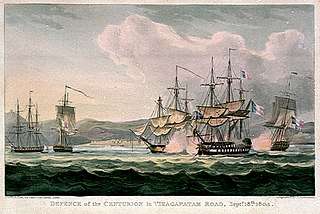
The Battle of Vizagapatam was a minor naval engagement fought in the approaches to Vizagapatam harbour in the Coastal Andhra region of British India on the Bay of Bengal on 15 September 1804 during the Napoleonic Wars. A French squadron under Contre-Admiral Charles-Alexandre Léon Durand Linois in the ship of the line Marengo attacked the British Royal Navy fourth rate ship HMS Centurion and two East Indiaman merchant ships anchored in the harbour roads. Linois was engaged in an extended raiding campaign, which had already involved operations in the South China Sea, in the Mozambique Channel, off Ceylon and along the Indian coast of the Bay of Bengal. The French squadron had fought one notable engagement, at the Battle of Pulo Aura on 15 February 1804, in which Linois had attacked the Honourable East India Company's (HEIC) China Fleet, a large convoy of well-armed merchant ships carrying cargo worth £8 million. Linois failed to press the attack and withdrew with the convoy at his mercy, invoking the anger of Napoleon when the news reached France.
The action of 4 August 1800 was a highly unusual naval engagement that took place off the Brazilian coast during the French Revolutionary Wars. A French frigate force that had been raiding British commerce off West Africa approached and attempted to attack a convoy of valuable East Indiamen, two ships sailing for Botany Bay, and a whaler sailing for the South Seas' whale fishery. The small British ship of the line HMS Belliqueux escorted the convoy, which otherwise had to rely on the ships' individual armament to protect them from attack. Due to their large size, the East Indiamen could be mistaken for ships of the line at a distance, and the French commander Commodore Jean-François Landolphe was un-nerved when the convoy formed a line of battle. Supposing his target to be a fleet of powerful warships he turned to escape and the British commander, Captain Rowley Bulteel, immediately ordered a pursuit. To preserve the impression of warships he also ordered four of his most powerful East Indiamen to join the chase.
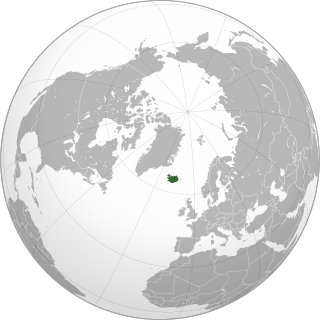
Operation FB took place as part of the Arctic Convoys of the Second World War. The operation consisted of independent sailings by unescorted merchant ships between Iceland and Murmansk. In late 1942, the Allies had taken the offensive against Germany but the dispatch of supplies to the USSR by convoy via the Arctic route was suspended, due to the demands of the Mediterranean campaign. Convoy PQ 19 was cancelled because the Home Fleet diverted ships to the Mediterranean for Operation Torch which would have had to be postponed for three weeks had ships been provided for PQ 19.

HMCS Raccoon was an armed yacht that served in the Royal Canadian Navy during World War II. Purchased by the Royal Canadian Navy in 1940, the ship was originally known as the yacht Halonia. Used as a patrol vessel and convoy escort, the ship was sunk by the German submarine U-165 in the St. Lawrence River on 7 September 1942. Raccoon was escorting Convoy QS-33 at the time. The entire ship's crew was lost.

The action of 7 May 1794 was a minor naval action fought between a British ship of the line and a French frigate early in the French Revolutionary Wars. The French Navy sought to disrupt British trade by intercepting and capturing merchant ships with roving frigates, a strategy countered by protecting British convoys with heavier warships, particularly in European waters. On 5 May 1794, the British escorts of a convoy from Cork sighted two French ships approaching and gave chase. The ships, a frigate and a corvette, outmatched by their opponents, separated and the convoy escorts did likewise, each following one of the raiders on a separate course.
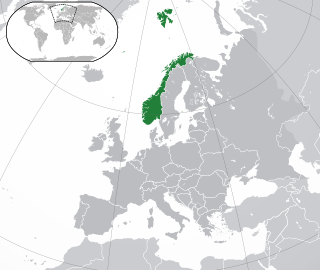
Convoy PQ 14 was an Arctic convoy sent from Britain by the Western Allies to aid the Soviet Union during the Second World War. Convoys from Britain had been despatched since August 1941 and advantage had been taken of the perpetual darkness of the Arctic winter. German operations against the convoys had been muted due to the need to support Operation Barbarossa, confidence in imminent victory and the small size of the convoys. In late 1941 and early 1942 the Luftwaffe and Kriegsmarine had reinforced Norway with aircraft and ships.

HMCS Rosthern was a Flower-class corvette that served in the Royal Canadian Navy during the Second World War. She served primarily in the Battle of the Atlantic as a convoy escort. She is named for Rosthern, Saskatchewan.

The Macau Incident was an inconclusive encounter between a powerful squadron of French and Spanish warships and a British Royal Navy escort squadron in the Wanshan Archipelago off Macau on 27 January 1799. The incident took place in the context of the East Indies campaign of the French Revolutionary Wars, the allied squadron attempting to disrupt a valuable British merchant convoy due to sail from Qing Dynasty China. This was the second such attempt in three years; at the Bali Strait Incident of 1797 a French frigate squadron had declined to engage six East Indiamen on their way to China. By early 1799 the French squadron had dispersed, with two remaining ships deployed to the Spanish Philippines. There the frigates had united with the Spanish Manila squadron and sailed to attack the British China convoy gathering at Macau.
SS Dekabrist was a Russian steamship, built in 1903 and immediately converted to an armed merchant cruiser. She served in the Russo-Japanese War, World War I, the Russian Civil War, and World War II. She was sunk in 1942.
References
- 1 2 "Richard Woodman". Fantastic Fiction. Retrieved 11 May 2011.
- ↑ "The Nathaniel Drinkwater series, by Richard Woodman". Archived from the original on 11 April 2011. Retrieved 11 May 2011.
- 1 2 3 "The Surprising History of the British Merchant Navy". The History Press. Retrieved 11 May 2011.
- ↑ "No. 60728". The London Gazette (Supplement). 31 December 2013. p. 4.
- ↑ "Nautical novels by Richard Woodman". Sheridan House. Retrieved 11 May 2011.